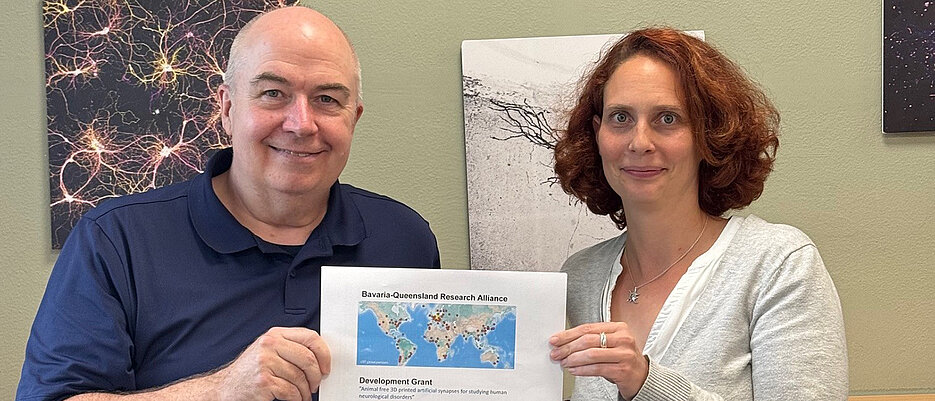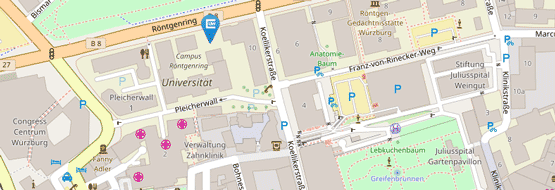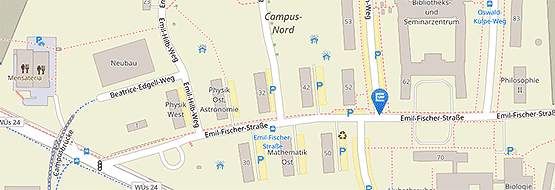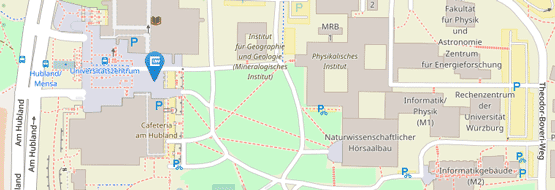International Co-operation in Medicine
11/25/2025Cooperation between Würzburg and Queensland receives funding: Complex models for complex diseases: 3D-printed synapses open up new ways of understanding childhood disorders of the nervous system.

Around 16,000 kilometres separate the University Hospital Würzburg (UKW) and the University of the Sunshine Coast (UniSC) in Queensland, Australia - but they are very close when it comes to research.
PD Dr. Natascha Schäfer from the Institute of Clinical Neurobiology at the UKW and her Australian colleague Professor Robert Harvey will receive state funding of 70,000 euros over two years as part of the Bavaria-Queensland Research Alliance. This funding will be supplemented by substantial in-kind contributions from private partners: PELOBiotech will provide human cell cultures, special cell culture media and media development solutions worth over 50,000 euros over the course of the project, while RevoBITs will contribute modern bioprinting technology and technical infrastructure totalling over 180,000 euros. With the development grant, the researchers are jointly developing an innovative, animal-free method for understanding neurological diseases.
"To really understand human diseases, we need human cell models," emphasises molecular medicine specialist Natascha Schäfer. "Our aim is to take research into the nervous system to a new level - without having to rely on animal tissue."
Schäfer and Harvey have already carried out pioneering work in the field of artificial synapses in recent years. In cell cultures, they succeeded in precisely controlling the activation of neuronal receptors and their partner proteins. This system provided important insights into the molecular mechanisms of signal transmission in the nervous system.
"However, our previous models are still dependent on animal tissue. At the same time, they are based on classic two-dimensional cell cultures in which growth in the Petri dish only takes place on a flat surface," explains Schäfer. "However, such a 2D environment does not replicate the three-dimensional organisation in which nerve cells in the brain or spinal cord are interconnected. In reality, they form a highly dynamic, spatial network - and that's exactly what we want to recreate in the lab."
From 2D to 3D: Bioprinting Supports the Production of Three-dimensional Neuronal Tissue Models
The new project therefore centres on the development of three-dimensional, bio-printed models of artificial synapses based on human induced pluripotent stem cells (iPSCs). These cells can be obtained from skin or blood cells and transformed into almost any cell type in the body. Supported by precise bioprinting, synapses - the switching points between nerve cells - can be modelled in a three-dimensional structure.
The team is drawing on the technology and expertise of the Bavarian 3D bioprinting start-up RevoBITs, whose bioprinting platform is being developed specifically for the production of sophisticated tissue models. The iPSC cells required are supplied by partner PELOBiotech, which provides a wide range of primary cells, stem cells and genetically modified cell systems.
"Working with animal tissue not only has ethical limits, but also restricts the research possibilities of many laboratories without animal facilities," explains Schäfer. "With our method, we want to create an accessible, reproducible system based on human cells."
In Focus: Autism Spectrum Disorders and Epilepsy
Schäfer's research group at the Institute of Clinical Neurobiology has been working on the development of three-dimensional tissue models of the spinal cord since 2022 in order to better understand diseases of the nervous system. Building on the findings from their previous 2D models, the researchers now want to analyse the complex neuronal switch points in a three-dimensional environment - especially those that play a role in childhood nerve diseases.
The new project is specifically focussing on neurological diseases in children. Over 60 million children worldwide suffer from such diseases - including autism spectrum disorders, epilepsy and developmental delays. Schäfer and Harvey are focussing on mutations in neurotransmitter receptors, which are crucial for communication between nerve cells. In particular, they are focussing on GABA and glycine receptors, whose malfunctions can lead to epilepsy, among other things.
"If we understand exactly how neuronal communication disorders affect children, we can develop the basis for new, personalised therapeutic approaches in the long term," says Schäfer.
Technological and Economic Boost for Bavaria and Queensland
The project not only brings scientific progress, but also harbours economic prospects: The development of complex 3D models based on human cells creates new biotechnological processes that can be used in the healthcare sector in many cases. The knowledge gained can accelerate the development of new drugs and patient-specific therapy concepts.
With patents, the development of specialised materials and new bioprinting technologies, the participating partners from Bavaria and Queensland want to strengthen their position in an international growth market.
The Bavaria-Queensland Research Alliance, which was launched in April 2024, specifically promotes cooperation between the two regions in the field of future technologies - from start-up funding for small projects to extensive research collaborations.
"This funding is an important step towards advancing innovative, animal-free research approaches worldwide," summarises Schäfer. "Together with our partners, we want to show that high-tech, ethics and medical progress can go hand in hand in modern research."






